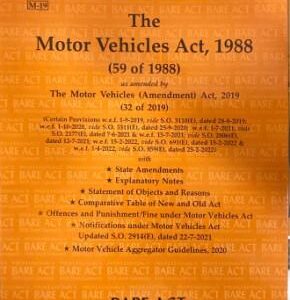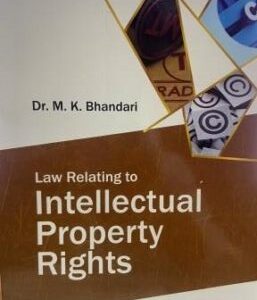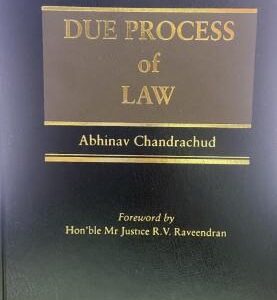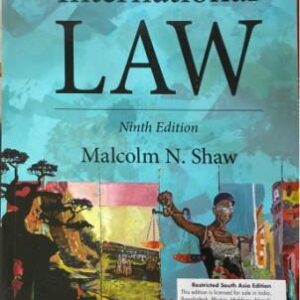Description
Transfer of Property Act is a student-centred textbook that follows a topic-wise architecture rather than a rigid section-by-section commentary. It explains each doctrine in context, cross-links relevant provisions from allied laws (such as Contract, Registration, Easements, CPC, and the Indian Succession Act), and embeds landmark case-law analyses into the narrative, allowing readers to see how courts interpret and apply the rules in practice. Background notes accompany major provisions to explain why the law evolved as it did, rather than merely what it states. Each chapter opens with a clear synopsis and closes with a concise ‘Summary’, with worked illustrations and case analyses embedded throughout for exam-ready understanding and practical application.
This book is intended for the following audience:
LL.B./B.A., LL.B. Students seeking a concept-first, exam-ready resource mapped to university syllabi
LL.M. Scholars & Researchers who need doctrinal depth with comparative notes (English/Indian positions) and legislative history
Practitioners, Academicians & Judicial Aspirants requiring a concise, cross-referenced explainer with case-law integration and practical insights
The Present Publication is the Latest Edition, authored by Prof. (Dr) Rajinder Kaur and Dr Rita Ghial, with the following noteworthy features:
[Topic-wise Pedagogy] Chapters cluster related concepts (e.g., conditional transfers, vested/contingent interests, notice, part performance), aiding intuitive learning and revision
[Cross-referencing Across Statutes] Correlates TPA provisions with the Contract Act, Registration Act, Easements Act, CPC, Indian Succession Act, and personal laws—highlighting where general rules yield to special regimes (e.g., Muslim law & waqf).
[Integrated Case-studies] Detailed, doctrine-wise discussion of seminal decisions (e.g., Duke of Norfolk, Whitby v. Mitchell, London & S.W. Ry v. Gomm, Jumma Masjid v. Deviah, Suraj Lamp) to illuminate principles and exam application
[‘Why’ Behind the Law] Legislative background, policy rationale, and historical evolution precede black-letter exposition—bridging theory and application.
[Practice Orientation] Clarifies registration/attestation requirements, notice doctrines, and consequences of invalid/void conditions with illustrations
[Student-centric Tone] Emphasis on comprehension over rote, with clear illustrations and comparative notes (Indian vs. English law)
[Scholarly Apparatus & Utility] Extensive case list, precise statutory extracts, and practical illustrations make it equally useful for classrooms, moots, and chambers
This book provides complete coverage of the Transfer of Property Act, 1882 (TPA), combining doctrinal clarity with practical illustrations and case-based analysis. The contents progress systematically from basic concepts to advanced doctrines governing the transfer of property in India. A brief overview of the major themes covered is as follows:
Foundations (Sections 1–4)
Explains the scope and structure of the Act, interpretation clauses, and its connection with the Contract Act and Registration Act. Clarifies what constitutes immovable property, the meaning of ‘attached to the earth,’ and key rules on attestation and registration
Essentials of a Valid Transfer (Sections 5–9)
Discusses the meaning of transfer, the competence of parties, and what can or cannot be transferred. Includes special discussions on spes successionis, actionable claims, oral transfers, and comparative perspectives with practical examples
Transfer for the Benefit of Unborn Persons & the Rule against Perpetuity (Sections 13, 14, 15, 16 and 18)
Covers how property can be transferred for the benefit of persons not yet born, the operation of trusts, and the limits imposed by the rule against perpetuity, with reference to Indian and English law
Conditional Transfers (Sections 10–12, 17, 25–34)
Explains transfers subject to conditions—such as restraints on alienation, conditions precedent and subsequent, and the doctrines of acceleration and conditional limitation
Vested and Contingent Interests; Election and Apportionment (Sections 19–24, 35–37)
Differentiates between vested and contingent interests, explores class gifts and uncertain events, and illustrates doctrines such as election and apportionment through clear examples
Notice and Unconscionable Transfers (Section 3 & Sections 39–41, 43, 53, 53A)
Explains actual and constructive notice, ostensible ownership, fraudulent transfers, and the celebrated doctrine of part-performance. Includes comparative commentary on English and Indian principles
Priority, Co-ownership, and Lis Pendens (Sections 38, 42, 44–52)
Examines the rights of co-owners, the effect of transfers made by them, and the priority of interests created by successive transfers, concluding with a detailed explanation of lis pendens
Sale of Immovable Property (Sections 54–57)
Discusses the essentials of a sale and contract for sale, along with the rights and liabilities of the buyer and seller, discharge of encumbrances, and the concept of marshalling
Mortgages and Charges (Sections 58–73, 76, 81–82, 91–96, 100–104)
Provides an in-depth treatment of the various kinds of mortgages, rights of redemption and foreclosure, duties of mortgagors and mortgagees, subrogation, and the creation and enforcement of charges—supported by key judicial decisions
Leases (Sections 105–117)
Clarifies the essentials of lease creation, the rights and duties of lessor and lessee, forfeiture and relief, holding over, and exemptions for agricultural leases
Exchange, Gift, and Actionable Claims (Sections 118–137)
Distinguishes between sale, exchange, and partition; discusses the essentials of a valid gift; and analyses how actionable claims are transferred under the Act
The structure of the book is as follows:
Concept → Background → Cross-links → Cases → Summary – Each topic follows a uniform didactic arc that begins with principle and ends in synthesis
Comparative Inserts – Indian vs. English law notes (e.g., perpetuities, Whitby v. Mitchell line, conditional limitations)
Boxed Illustrations & Step-wise Analyses – For doctrines like election, acceleration, notice, priorities, marshalling, subrogation, etc.
End-caps – One-page ‘Summary’ snapshots per chapter help last-mile revision for viva/exams

![Taxmann's Transfer of Property Act [TP]](https://hindlawhouse.com/wp-content/uploads/2025/10/9789371260022.jpg)




Reviews
There are no reviews yet.